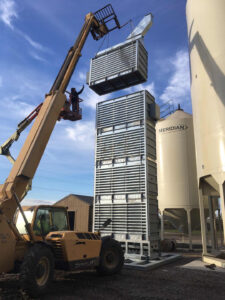Good vibrations – Drying grain with radio waves

Whether propane or natural gas, fuel costs can be an enormously burdensome expense for farmers and grain handlers. For Minnesota-based company Dry Max Solutions, radio waves offer an alternative method for drying grain free of both petroleum expenses and heat.
Kevin Eichhorn, founder of Dry Max Solutions, describes the company’s system as “forcefield drying.” That is, drying grains from the inside out. Radio waves energize the moisture within the crop by causing the separation of water molecules from each other (not the separation of Hydrogen and Oxygen atoms as individual elements). The separated and thus vaporized water molecules can then exist the crop more easily, and be removed with moving air more quickly.
Drying grains from the inside out

Dry Max’s website describes the process thusly: “We dry from the inside out. Our waves can pass through the tough shell to protect the most vital part of the grain, targeting the highest moisture first. Instead of drying grains outside in with heat, we push water out from the inside. There is no limit to the amount of material that can be dried per hour…The modular design means variable conditions and amounts are not an issue.”
Eichhorn emphasizes the process is similar in idea, but very different, than microwaving and other drying processes common to the manufacture of some textile and construction material. While radio waves do not produce significant heat, microwaving, kilning and other processes do.
Dozens of crops tested
The trick is refining the process for differing crop characteristics. Dozens of crops have been tested, and different drying results noted. Large bales of alfalfa, for example, can be dried quite quickly. The physical structures of wheat and barley are such that moisture can escape from the seed shell fairly easily too, which also lends to faster drying times. Corn is a tougher nut to crack, by comparison, since moisture cannot escape the kernel as easily with an intact shell.
“That’s some of the limitations,” says Eichhorn, reiterating crops like alfalfa and hops can be dried “crazy fast.” He adds the technology also helps ensure uniformity throughout the storage vessel. With fewer moisture pockets within the grain mass, higher quality, less spoilage, and reduced fire risk results.
Fuel savings
Fuel savings are a critical part of the marketing for Eichhorn and his company. Indeed, the high price associated with petroleum-based grain drying is a longstanding economic and environmental issue, and one common to many parts of the globe.
High electricity cost means its more expensive, but it’s still like one-tenth a per cent of petroleum
The electricity used to power a radio wave system is not free either, of course, and can vary in cost just like natural gas and propane. Eichhorn says the availability of cheaper electricity is a boon for those interested in all-electric drying, but the cost-to-saving equation of shifting away from fossil fuels is likely to pencil even in places where electricity costs are higher.
“It’s a little high on electricity cost for sure. High electricity cost means its more expensive, but it’s still like one-tenth a per cent of petroleum,” he says.
The company’s current design resembles standard continuous-flow tower driers, standing between 60 and 80 feet high (18 to 27 metres) and 12 feet wide (3.5 metres). Eichhorn is now in the process of commercializing the system alongside a partnering grain handler in Manitoba.



